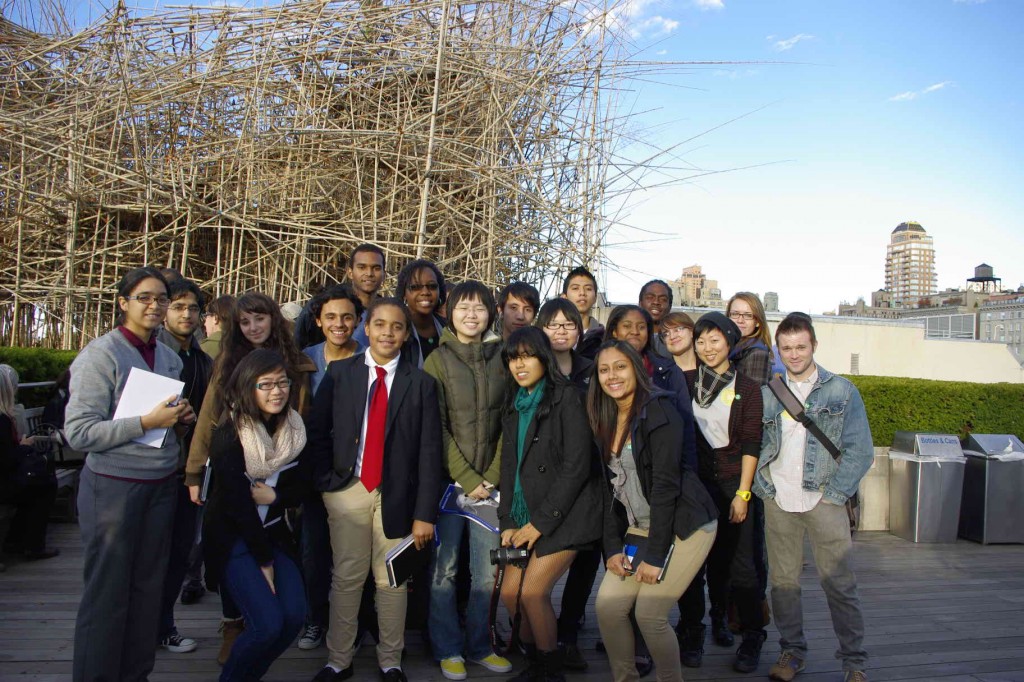Posted by Calder Zwicky, Associate Educator, Teen and Community Programs
For this series of posts, I’ve asked the teaching artists from this season’s In the Making Art Classes to reflect on what they’ve been doing over the past couple of weeks with their teenaged students. Each In the Making class meets once a week—Tuesday or Thursday nights—and focuses on introducing the participants to the materials, techniques, artistic theories, and exhibitions currently on view in MoMA’s galleries. It’s a great way for teens to find a community of positive, creative peers outside of a high school setting, and all classes are offered completely free of charge to the participating students. For this entry, teaching artist Grace Hwang explores her process of introducing students to the themes and philosophies behind our Small Scale, Big Change: New Architectures of Social Engagement exhibition.
—Calder Zwicky, Associate Educator, Teen and Community Programs

Social Architecture students at The Metropolitan Museum of Art's Big Bambú installation, by Doug and Mike Starn (2010).
For the past seven weeks, the teens and I have been studying the latest practices and projects around the world that engage communities’ current social issues and serve their needs for housing and transportation as well. We’ve been using the following question as a guidepost as we move through this ten-week class: Can an answer to social issues such as poverty be found within the design of our city’s buildings and community spaces? At this point, I think that most of the students in class would answer with a resounding YES!
In the first class, I had the students imagine temporary dwellings for our families based on the traditional Jewish festival of Sukkot, following the holiday’s strict parameters for design. Kiersten Nash, an artist and designer here in NYC, met with the class and shared her entry to the Sukkah City Design Competition, currently on view at the Center for Architecture.
Leaving the confines of MoMA’s classrooms, we navigated the Starn Brothers’ evolving Big Bambúinstallation on the roof of The Metropolitan Museum of Art and tried our hands at proposing a rooftop sculpture for the museum—one that would respond to its situated environment: both in the context of the Museum’s roof, as well as from within Central Park.
We’ve studied the projects in the Small Scale, Big Change: Architectures for Social Engagement exhibition as well, and brought the teens through the show on a fascinating guided tour given to us by Andres Lepik, the exhibition’s curator, and curatorial assistant Margot Weller. Andres introduced us to the idea of architects acting as editors: finding improvements to existing structures, as opposed to creating new building projects altogether.

Left: Curator Andres Lepik takes the teens through the Small Scale, Big Change exhibition. Right: Curatorial assistant Margot Weller describes a section of the exhibition.
What we’ve begun to see is that what makes architecture social is not only that it responds to basic needs to survive (for both humans and the environment), but that it also responds to what we need for our society to thrive: spaces that strengthen the social fabric of a community, and building practices that honor native architecture and establish local pride.
The teens are currently researching and tackling issues near to our hearts: homelessness in NYC, literacy in rural China, the energy crises in Pakistan, overpopulation in Hong Kong… to name just a few. Like the exhibition from which we have been drawing our inspiration, the class is a small seed of an idea, with big implications for change!
Come see the students’ solutions at the Fall 2010 In the Making Exhibition, on view from December 17 to January 20 in MoMA’s Cullman Education and Research Building.
http://www.moma.org/explore/inside_out/2010/11/24/educator-journal-in-the-making-social-architecture
No hay comentarios:
Publicar un comentario